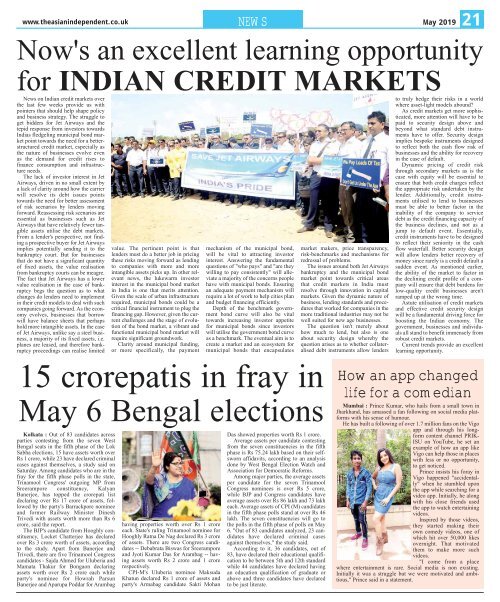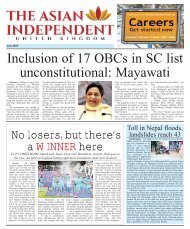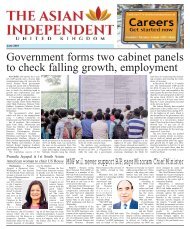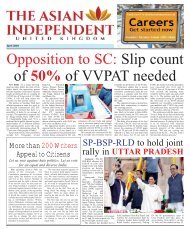Create successful ePaper yourself
Turn your PDF publications into a flip-book with our unique Google optimized e-Paper software.
www.theasianindependent.co.uk<br />
NEWS<br />
<strong>May</strong> <strong>2019</strong><br />
21<br />
Now's an excellent learning opportunity<br />
for INDIAN CREDIT MARKETS<br />
News on Indian credit markets over<br />
the last few weeks provide us with<br />
pointers that should help shape policy<br />
and business strategy. The struggle to<br />
get bidders for Jet Airways and the<br />
tepid response from investors towards<br />
Indias fledgeling municipal bond market<br />
point towards the need for a betterstructured<br />
credit market, especially as<br />
the nature of businesses evolve even<br />
as the demand for credit rises to<br />
finance consumption and infrastructure<br />
needs.<br />
The lack of investor interest in Jet<br />
Airways, driven in no small extent by<br />
a lack of clarity around how the carrier<br />
will resolve its debt issues points<br />
towards the need for better assessment<br />
of risk scenarios by lenders moving<br />
forward. Reassessing risk scenarios are<br />
essential as businesses such as Jet<br />
Airways that have relatively fewer tangible<br />
assets utilise the debt markets.<br />
From a lender's perspective, not finding<br />
a prospective buyer for Jet Airways<br />
implies potentially sending it to the<br />
bankruptcy court. But for businesses<br />
that do not have a significant quantity<br />
of fixed assets, the value realisation<br />
from bankruptcy courts can be meagre.<br />
The fact that Jet Airways has a lower<br />
value realisation in the case of bankruptcy<br />
begs the question as to what<br />
changes do lenders need to implement<br />
in their credit models to deal with such<br />
companies going forward. As the economy<br />
evolves, businesses that borrow<br />
will have balance sheets that perhaps<br />
hold more intangible assets. In the case<br />
of Jet Airways, unlike say a steel business,<br />
a majority of its fixed assets, i.e.<br />
planes are leased, and therefore bankruptcy<br />
proceedings can realise limited<br />
value. The pertinent point is that<br />
lenders must do a better job in pricing<br />
these risks moving forward as lending<br />
to companies with more and more<br />
intangible assets picks up. In other relevant<br />
news, the lukewarm investor<br />
interest in the municipal bond market<br />
in India is one that merits attention.<br />
Given the scale of urban infrastructure<br />
required, municipal bonds could be a<br />
critical financial instrument to plug the<br />
financing gap. However, given the current<br />
challenges and the stage of evolution<br />
of the bond market, a vibrant and<br />
functional municipal bond market will<br />
require significant groundwork.<br />
Clarity around municipal funding,<br />
or more specifically, the payment<br />
mechanism of the municipal bond,<br />
will be vital to attracting investor<br />
interest. Answering the fundamental<br />
questions of "who pays" and "are they<br />
willing to pay consistently" will alleviate<br />
a majority of the concerns people<br />
have with municipal bonds. Ensuring<br />
an adequate payment mechanism will<br />
require a lot of work to help cities plan<br />
and budget financing efficiently.<br />
Depth of the benchmark government<br />
bond curve will also be vital<br />
towards increasing investor appetite<br />
for municipal bonds since investors<br />
will utilise the government bond curve<br />
as a benchmark. The eventual aim is to<br />
create a market and an ecosystem for<br />
municipal bonds that encapsulates<br />
market makers, price transparency,<br />
risk-benchmarks and mechanisms for<br />
redressal of problems.<br />
The issues around both Jet Airways<br />
bankruptcy and the municipal bond<br />
market point towards critical areas<br />
that credit markets in India must<br />
resolve through innovation in capital<br />
markets. Given the dynamic nature of<br />
business, lending standards and procedures<br />
that worked for companies in the<br />
more traditional industries may not be<br />
well suited for new age businesses.<br />
The question isn't merely about<br />
how much to lend, but also is one<br />
about security design whereby the<br />
question arises as to whether collateralised<br />
debt instruments allow lenders<br />
to truly hedge their risks in a world<br />
where asset-light models abound?<br />
As credit markets get more sophisticated,<br />
more attention will have to be<br />
paid to security design above and<br />
beyond what standard debt instruments<br />
have to offer. Security design<br />
implies bespoke instruments designed<br />
to reflect both the cash flow risk of<br />
businesses and the ability for recovery<br />
in the case of default.<br />
Dynamic pricing of credit risk<br />
through secondary markets as is the<br />
case with equity will be essential to<br />
ensure that both credit charges reflect<br />
the appropriate risk undertaken by the<br />
lender. Additionally, credit instruments<br />
utilised to lend to businesses<br />
must be able to better factor in the<br />
inability of the company to service<br />
debt as the credit financing capacity of<br />
the business declines, and not as a<br />
jump to default event. Essentially,<br />
credit instruments have to be designed<br />
to reflect their seniority in the cash<br />
flow waterfall. Better security design<br />
will allow lenders better recovery of<br />
money since rarely is a credit default a<br />
sudden event. As mentioned earlier,<br />
the ability of the market to factor in<br />
the declining credit profile of a company<br />
will ensure that debt burdens for<br />
low-quality credit businesses aren't<br />
ramped up at the wrong time.<br />
Astute utilisation of credit markets<br />
and effective credit security design<br />
will be a fundamental driving force for<br />
boosting the Indian economy. The<br />
government, businesses and individuals<br />
all stand to benefit immensely from<br />
robust credit markets.<br />
Current trends provide an excellent<br />
learning opportunity.<br />
15 crorepatis in fray in<br />
<strong>May</strong> 6 Bengal elections<br />
Kolkata : Out of 83 candidates across<br />
parties contesting from the seven West<br />
Bengal seats in the fifth phase of the Lok<br />
Sabha elections, 15 have assets worth over<br />
Rs 1 crore, while 23 have declared criminal<br />
cases against themselves, a study said on<br />
Saturday. Among candidates who are in the<br />
fray for the fifth phase polls in the state,<br />
Trinamool Congress' outgoing MP from<br />
Sreerampore constituency, Kalyan<br />
Banerjee, has topped the crorepati list<br />
declaring over Rs 17 crore of assets, followed<br />
by the party's Barrackpore nominee<br />
and former Railway Minister Dinesh<br />
Trivedi with assets worth more than Rs 6<br />
crore, said the report.<br />
The BJP's candidate from Hooghly constituency,<br />
Locket Chatterjee has declared<br />
over Rs 3 crore worth of assets, according<br />
to the study. Apart from Banerjee and<br />
Trivedi, there are five Trinamool Congress<br />
candidates - Sajda Ahmed for Uluberia and<br />
Mamata Thakur for Bongaon declaring<br />
assets worth over Rs 2 crore each while<br />
party's nominee for Howrah Parsun<br />
Banerjee and Aparupa Poddar for Arambag<br />
having properties worth over Rs 1 crore<br />
each. State's ruling Trinamool nominee for<br />
Hooghly Ratna De Nag declared Rs 3 crore<br />
of assets. There are two Congress candidates<br />
-- Debabrata Biswas for Sreerampore<br />
and Jyoti Kumar Das for Arambag -- having<br />
assets worth Rs 2 crore and 1 crore<br />
respectively.<br />
CPI-M's Uluberia nominee Maksuda<br />
Khatun declared Rs 1 crore of assets and<br />
party's Armabag candidate Sakti Mohan<br />
Das showed properties worth Rs 1 crore.<br />
Average assets per candidate contesting<br />
from the seven constituencies in the fifth<br />
phase is Rs 75.24 lakh based on their selfsworn<br />
affidavits, according to an analysis<br />
done by West Bengal Election Watch and<br />
Association for Democratic Reforms.<br />
Among major parties, the average assets<br />
per candidate for the seven Trinamool<br />
Congress nominees is over Rs 5 crore,<br />
while BJP and Congress candidates have<br />
average assets over Rs 86 lakh and 73 lakh<br />
each. Average assets of CPI (M) candidates<br />
in the fifth phase polls stand at over Rs 46<br />
lakh. The seven constituencies will go to<br />
the polls in the fifth phase of polls on <strong>May</strong><br />
6. "Out of 83 candidates analyzed, 23 candidates<br />
have declared criminal cases<br />
against themselves," the study said.<br />
According to it, 36 candidates, out of<br />
83, have declared their educational qualification<br />
to be between 5th and 12th standard<br />
while 44 candidates have declared having<br />
an education qualification of graduate or<br />
above and three candidates have declared<br />
to be just literate.<br />
How an app changed<br />
life for a comedian<br />
Mumbai : Prince Kumar, who hails from a small town in<br />
Jharkhand, has amassed a fan following on social media platforms<br />
with his sense of humour.<br />
He has built a following of over 1.7 million fans on the Vigo<br />
app and through his longform<br />
content channel PRIK-<br />
ISU on YouTube, he set an<br />
example of how an app like<br />
Vigo can help those in places<br />
with less or no opportunity,<br />
to get noticed.<br />
Prince insists his foray in<br />
Vigo happened "accidentally"<br />
when he stumbled upon<br />
the app while searching for a<br />
video app. Initially, he along<br />
with his close friends used<br />
the app to watch entertaining<br />
videos.<br />
Inspired by those videos,<br />
they started making their<br />
own comedy videos, one of<br />
which hit over 50,000 likes<br />
overnight. That motivated<br />
them to make more such<br />
videos.<br />
"I come from a place<br />
where entertainment is rare. Social media is non existing.<br />
Initially it was a struggle but we were motivated and ambitious,"<br />
Prince said in a statement.
















